Positioning and Synchronicity on Paper
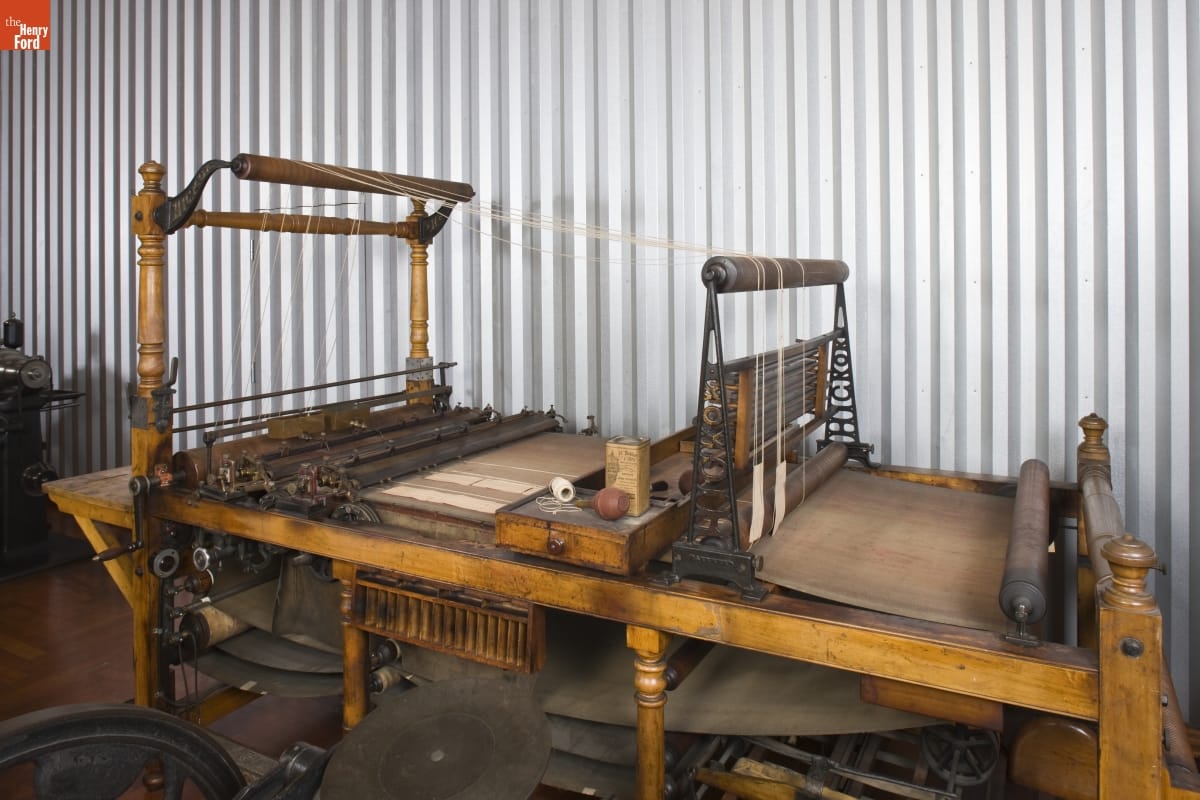
THF91558 (Photographed by John Sobczak)
In the early 19th century, lined paper was generally used only in business ledgers and account books. And the ruling was done by hand using cylindrical rulers and dip pens. Imagine the tedious hours that went into ruling just one book, with multiple colored lines as well as many stop lines, cross lines and sets of double as well as single lines.
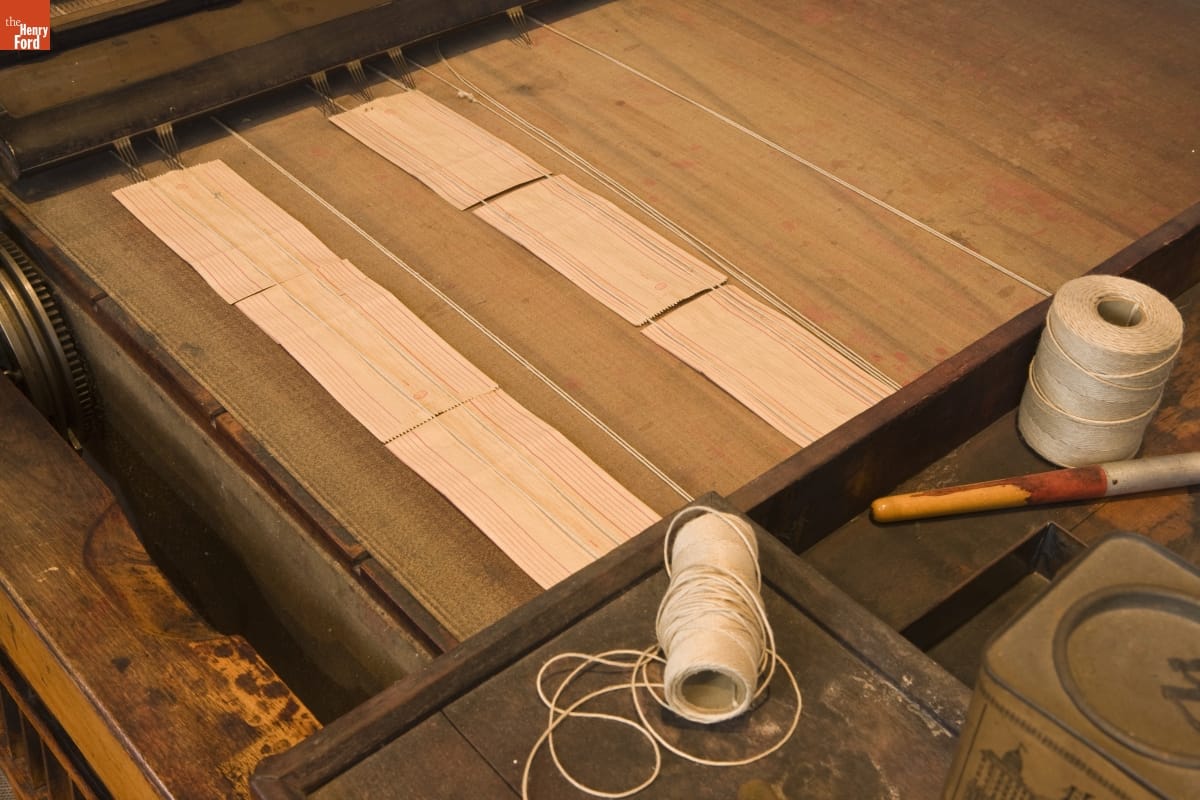
In the 1840s, William Orville Hickok got to work on improving this by-hand paper-ruling process, inventing a machine that had a moving belt running beneath a set of pen nibs held in place by a crossbar. Cotton threads, dipped into a trough of ink containers, kept the overhead pens moist. Ink was applied from the mounted pens to the paper fed through the machine — an exercise in perfect positioning and synchronicity.
Learn more about William Orville Hickok and his contributions to the paper-ruling business, and see the 1913 Hickok Paper Ruling Machine for yourself in Made in America at Henry Ford Museum of American Innovation. The Hickok paper-ruling machine was donated by Carl H. Dubac of Saginaw, Michigan, in 1986. Dubac’s father, who bound books by hand for more than 60 years, used the machine to line paper for ledger books.
Additional Readings:
- Made in America: Manufacturing- Thomas Blanchard’s Wood Copying Lathe
- Women in Industry and at Home in WWI
- The Wool Carding Machine
making, manufacturing, communication, Henry Ford Museum, Made in America
Lessons From the Past, Visions for the Future
art, making, Greenfield Village buildings, glass, artists in residence, Greenfield Village
When the 29 millionth Ford came off the assembly line in 1941 there was no doubt who the owner would be - a group of American Red Cross volunteers were waiting for the keys as the car rolled into sight. The donation of the vehicle was just a small part of the role Ford Motor Company undertook with the American Red Cross during World War II. Both Henry and Edsel Ford not only made large monetary donations and sponsored blood drives and fundraisers at Ford plants, but they also gave space, teachers, supplies, and vehicles to the Detroit Chapter of the American Red Cross Motor Corp.
Edsel Ford Presents the 29-Millionth Ford to the Red Cross, April 29, 1941.
THF270135
The Motor Corp., which was started during WWI in 1918, was a segment of the American Red Cross made up of women civilian volunteers. They were responsible for transporting wounded and sick soldiers to various hospitals; conveying donated blood, supplies, and food to airstrips for over overseas transport, and also driving hospital volunteers, Red Cross personnel, and visiting military family members to hospitals, recovery centers, and funeral homes. The Motor Corp. served the Army, Navy, Coast Guard, Blood Blank, various social agencies, and the USO. These women provided their own vehicles, gas, time, and tools and also had to purchase their uniform, and insignias for their cars.
Not only were volunteers in the Motor Corp. required to provide their own vehicles but they had to perform their own maintenance as well. Many of the volunteers had never been called on to service a car, and with wartime restrictions on materials, auto repair was even more difficult. Ford Motor Company stepped in to offer mechanics training courses to Detroit Chapter Motor Corp. volunteers. The Company provided trained mechanics, free of charge, to teach groups of volunteers the basics of car maintenance. According to the National Red Cross Motor Corp. Volunteer Special Services Manual, the mechanics course should cover how to “change a tire, apply chains, replace light bulbs, check gas flow at carburetor back through fuel pump to tank, check battery, check loose electrical connections, check spark plugs, and check electrical current at generator and distributor.” Volunteers didn’t have it easy, instructor were encouraged to “disconnect various electrical wires and parts of the gas pipe system” so members could analyze what was wrong and fix it. Ford opened up rooms in Highland Park for many of the training classes in 1941, and dealerships all over Detroit were made available for evening classes. The classwork included both informational lecture instruction and hands-on training on automobiles. The company also provided trucks for driving tests, and other equipment needed by the local Corp.

Red Cross Women's Motor Corps Workers Learn about Auto Maintenance, March 1941. THF269991
The first vehicle Ford donated to the Red Cross during WWII was an important vehicle to the company. The car was a Super Deluxe Ford Station Wagon, but this was no ordinary car, it was the 29 millionth Ford car produced in their 38 year history. The car sported the Motor Corp. insignia on the front door and carried a ceremonial license plate of "29,000,000." The morning of April 29, 1941, found Edsel Ford with a group of volunteers from the Motor Corp. of the Detroit chapter of the American Red Cross. A dozen or so representatives of the Motor Corp gathered with Ford as the car rolled to the end of the line. Edsel handed off the keys to the Captain of the Detroit Motor Corp, Barbara Rumney, who took the wheel as Edsel joined her for a ride in the new car.

Edsel Ford Presents the 29-Millionth Ford to the Red Cross Women's Motor Corps, April 29, 1941. THF270143
By 1942, the Detroit Chapter of the Motor Corp. had over 1,300 trained volunteers, and after Ford’s donation of the 29 millionth car, had added 22 other pieces of equipment to broaden their reach and impact. Barbara Rumney wrote Ford stating “We realize that if it had not been for your generous response, we could not have attempted many of the things that we are doing to serve our country in its crisis.” Over the course of World War II 45,000 women volunteered for the American Red Cross Motor Corp. driving 41 million miles to support the war effort.

Red Cross Women's Motor Corps Worker Learning about Auto Maintenance, November 1941. THF270091
Kathy Makas is a Reference Archivist for the Benson Ford Research Center at The Henry Ford. There’s plenty more in our collections on Ford Motor Company and the war effort. Visit the Benson Ford Research Center Monday-Friday from 9:00 am to 5:00 pm. Set up an appointment in the reading room or AskUs a question.
women's history, education, Michigan, Detroit, Edsel Ford, cars, World War II, World War I, by Kathy Makas, philanthropy, healthcare, Ford Motor Company
Art Deco at The Henry Ford

"Art Deco" refers to the artistic movement prominent during the inter-war period. The 1925 Exposition Internationale des Arts Décoratifs et Industriels Modernes in Paris was the launching point for the movement, as well as the inspiration for its name. The aesthetic was widely adopted, both geographically and across disciplines.

In this expert set, Art Deco in the Museum, you'll see examples of art deco artifacts that are on display in Henry Ford Museum of American Innovation, like this 1937 LaSalle Coupe found in Driving America.

In this expert set, Art Deco - Behind the Scenes, we've put together a collection of art deco-related artifacts, like the 1940 Sentinel Wafer Electric Clock that aren't currently on display but are in our digital collections.
The Henry Ford and House Industries

Tray of Wood Type, circa 1840. THF159398
The Henry Ford and House Industries, two institutions committed to celebrating the spirit of innovation, joined forces to create House Industries: A Type of Learning, an exhibit in Henry Ford Museum of American Innovation from May 27 through September 4, 2017.
Artifacts provided by House Industries and others are complemented by pieces from our own collections, like this tray of wood type from around 1840. These items can be seen in the exhibit or in this expert set. Regardless of where you see them for yourself, these artifacts showcasing design might just spark your own creative moment.
A Feather Duster for Your Flivver

Many of us like to keep our cars clean. Whether it’s with a trip through the automatic car wash, or a hosing and waxing in the driveway, we try to keep the mud, dirt and grime away. Some of us spend just as much time on the interiors, crawling over seats with a shop vac in hand. A car is a big investment and, the more expensive something is, the better care we’re likely to give it.
An automobile was no less an investment a century ago. Even at its absolute lowest price of $260 in 1924, a Ford Model T cost one-fifth of the average annual wage in the United States. Not surprisingly, many car owners took great pains to keep their cars neat and tidy – both to ensure that the vehicle remained in top condition, and as a more basic point of pride. We recently acquired one of the key tools for a fastidious flivver owner – an “Automobile Special” feather duster from the 1920s.
A look at period mail-order catalogs reveals any number of cleaning products available to motorists in the 1910s and 1920s. Montgomery Ward’s 1916 supplemental automobile equipment catalog grouped its cleaning products under the breezy heading, “A Clean Auto Means a More Attractive Auto.” Its pages include a mix of waxes and polishes easily recognizable today, along with archaic products like “Neats Foot Oil Clutch Compound” (used to soften a leather-surfaced clutch that engaged too abruptly). The mail-order giant’s larger Catalog and Buyer’s Guide No. 93 from 1920 devotes most of page 894 to car cleaning. Ward’s offered waxes, enamels, rubber floor mats, horsehair washing brushes, and renewing compounds for leather roofs. The duster advertised on that page is captioned with a helpful – and persuasive – warning: “Do not let dust remain on the finish of your car as it quickly works its way into the paint which kills the luster.”
On that note, our “Automobile Special” duster likely wasn’t recommended for exterior surfaces. Those ten-inch turkey feathers – with their tendency to scratch – would scare off any discerning car owner, then or now. The choosy motorist would have selected a “dustless duster” with chemically-treated fibers designed to absorb dust rather than push it around. They were readily available 100 years ago but, naturally, they came at an extra cost – 35 cents versus 14 cents for a comparable feather duster. Nevertheless, a feather duster could have been safely used to tidy up an auto’s interior surfaces, and many surely were.
While we have other feather dusters in the collection, they likely were intended for use in the home. None is specifically labeled as being for automotive use. This newly-acquired “Automobile Special” duster is an important piece – rough on the paint or not – in that it gets us to the stories of automotive maintenance and pride of ownership in the 1920s, when automobiles were priced within reach of most Americans.
Matt Anderson is Curator of Transportation at The Henry Ford.
Printing Presses: Information Machines

Linotype Composing Machine, circa 1915. THF126838
For the past 25 years House Industries has been known for their unique font collections. Their fonts have been used to create logos for some of the best-known brands, from entertainers to news outlets. At The Henry Ford, our collections house some important printing presses. The printing press democratized knowledge. As mechanical improvements were made, printing became faster and cheaper. By extension, the content of newspapers and books diversified, and the printed word was distributed on a mass scale.
This collection documents the mechanical lineage of printing presses, from a circa 1809 Ramage--one of the oldest surviving hand presses in the country--to the efficient Mergenthaler Linotype composing machine.
Artist in Residence: Herb Babcock
Meet our next artist in residence, Herb Babcock.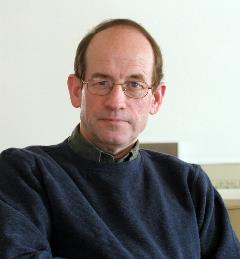 Tell us a little bit about yourself and your work.
Tell us a little bit about yourself and your work.
I was born in a small town in Ohio in 1946. I received a BFA in Sculpture from the Cleveland Institute of Art, Cleveland, Ohio in 1969 and an MFA in Sculpture from Cranbrook Academy of Art, Bloomfield Hills, Michigan in 1973. I studied sculpture at the Skowhegan School of Painting and Sculpture, Skowhegan, Maine 1967 and glass at the Toledo Museum of Art, Toledo, Ohio from 1970-71.
I am Professor Emeritus, College for Creative Studies. I taught at CCS for 40 years. Currently I indulge myself in the studio, conceptualizing and creating art.
Fire began to dominate my art in 1969, the first time I tried to blow glass. As a sculptor, I was forging steel into “form.” Molten glass was an alternative: a hot, quick and scary medium to make art. Once I immersed myself in the glass process, the material became a “fine art” medium for me. 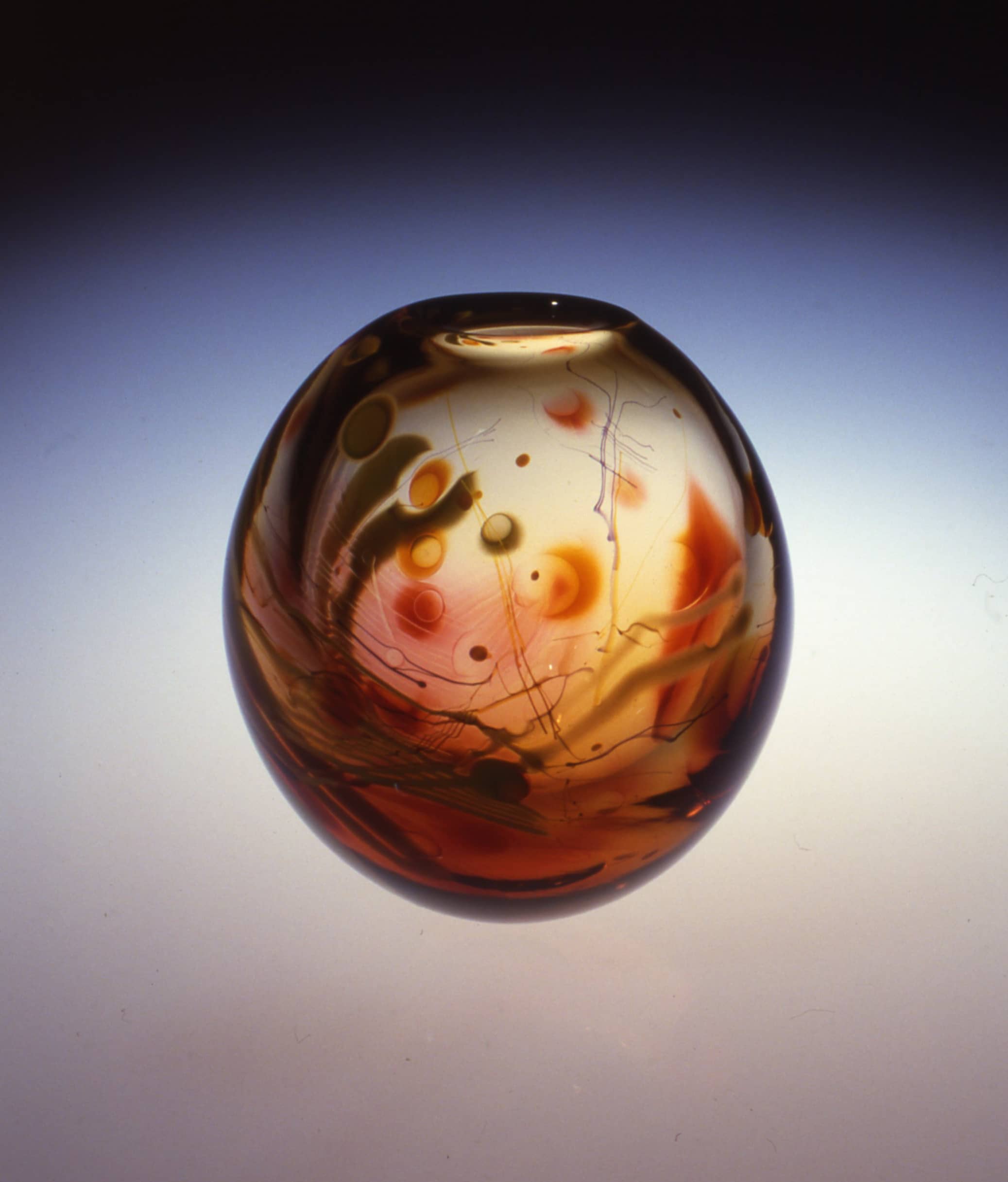
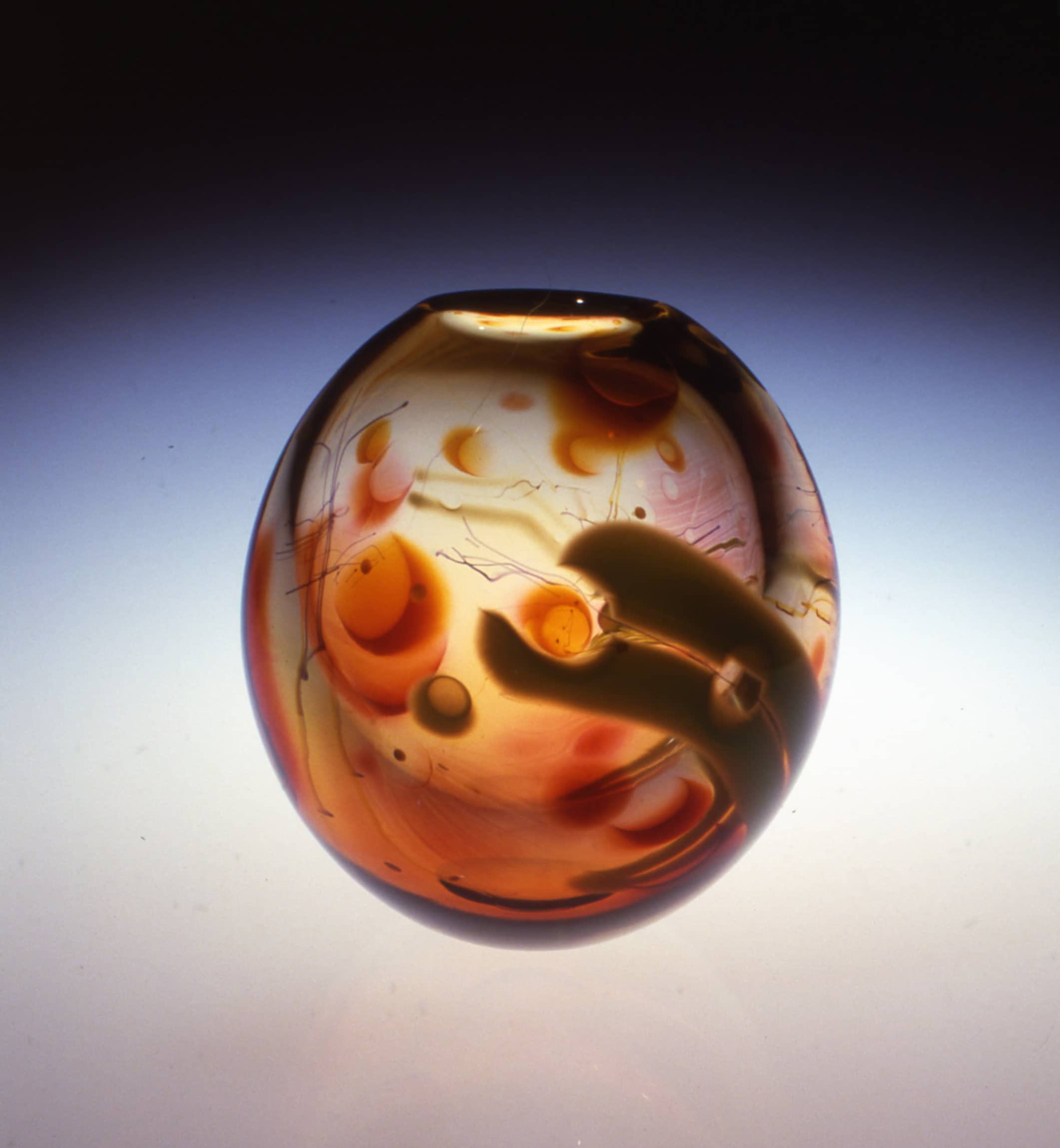
As my glass skills evolved and I explored a new process, I created the Image Vessel Series in 1976. In this series, I “painted” using color and line, and “sculpted” to produce a three-dimensional image through a blown-glass vessel.
Do you have a favorite piece you’ve created?
Not one favorite piece; however, each step in the evolution of my work has produced several pieces that I believe interpret what I am trying to say.
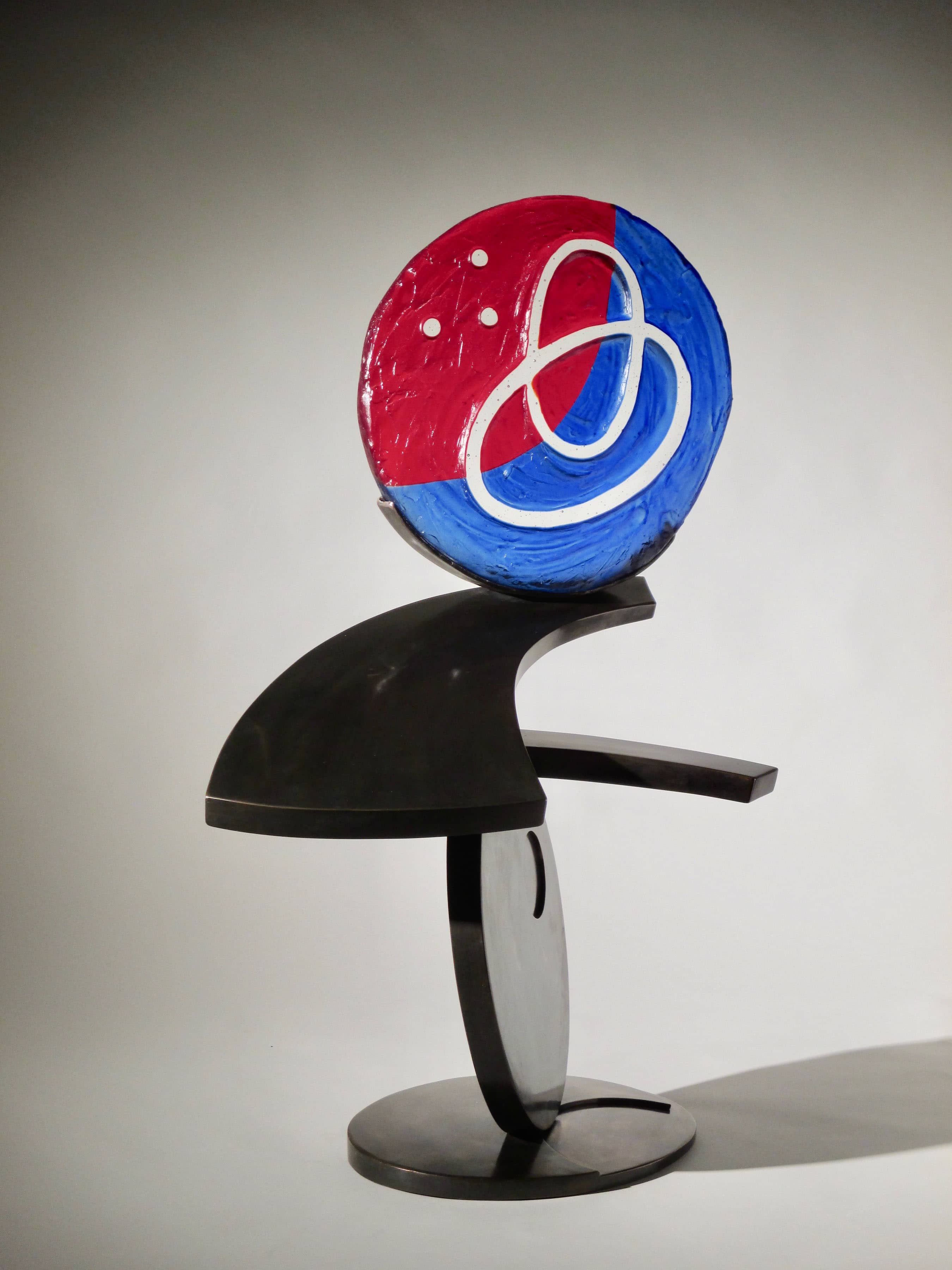
Why do you enjoy working with glass?
The three-dimensional world is reflected light and shadow. Glass adds transparency and translucency. Together this considerably expands the vocabulary of sculpture.
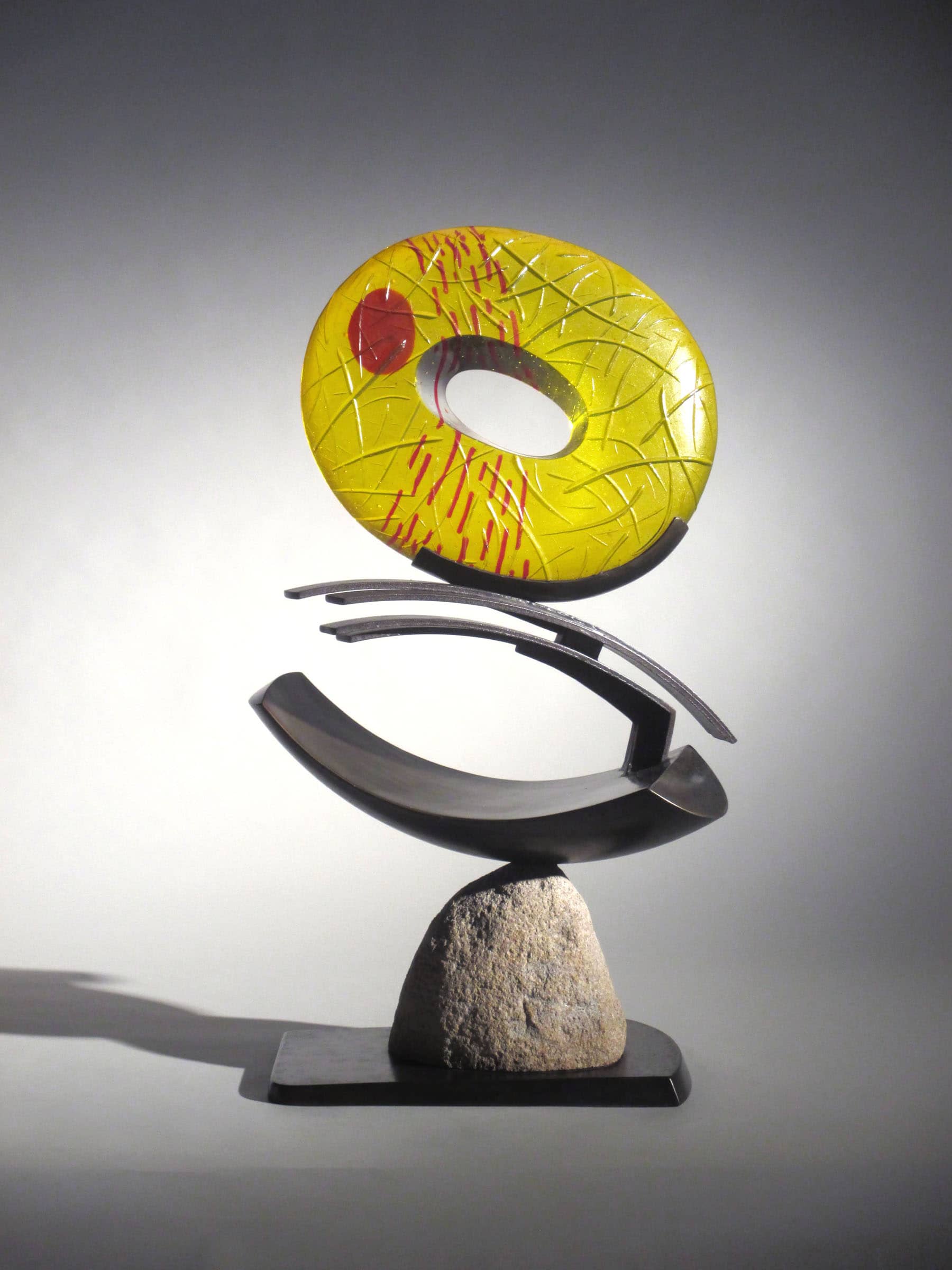
Where do you find your inspiration for your creations?
Inspiration comes from the “human figure” along with its movement and stance.
What are you most looking forward to while being an Artist in Residence at The Henry Ford?
I look forward to working with the highly skilled artisans that make up the Henry Ford glass studio. I hope to produce a three- dimensional interpretation of my Image Vessel Series.
Michigan, Dearborn, 21st century, 20th century, making, Greenfield Village, glass, artists in residence, art
Counterculture Makes the Scene

Record Album, "Sgt. Pepper's Lonely Hearts Club Band," 1967. THF 113167
Fifty years ago this month, the Beatles released their album "Sgt. Pepper’s Lonely Hearts Club Band." Thousands of young people flocked to San Francisco to experience the "Summer of Love."
The summer of 1967 saw the flowering of a counterculture movement, a reaction against the moral complacency and social conformity of postwar America, that would create ripples of change in American society in the coming years. An alternative vision of living—vastly different from the traditional and conformist 1950s—ignited the imaginations of millions of young Americans who came of age during the 1960s. The times, they were a-changing.
Sgt. Pepper’s Lonely Hearts Club Band
When the Beatles released their album "Sgt. Pepper’s Lonely Hearts Club Band" in June 1967, it inspired a generation with optimism and an alternative vision of possibility. Young people had eagerly waited for it in great anticipation—it was the first album whose release was truly an "event."
By the time the Beatles recorded "Sgt. Pepper," they were beginning to incorporate a variety of new influences in their music, including a broader range of instruments—including an Indian sitar—and innovative recording techniques. The album features elaborate musical arrangements and use of studio effects like echo and reverberation. The album cover was truly smashing. It featured a colorful collage of cardboard models of famous people—at its center appeared the Beatles themselves, dressed in day-glo satin military band-style outfits. With its mystical influences, psychedelic music, and fanciful album art, "Sgt. Pepper" encapsulated the very essence of counterculture aesthetic.
Millions around the world were galvanized by "Sgt. Pepper’s" music and message. Alienated youth, searching for a better society and a good life, were entranced by the Beatles’ vision of what could be, rather than what was. The album quickly anointed the Beatles as leaders of the 1960s counterculture movement.
The Summer of Love
If "Sgt. Pepper" was the quintessential counterculture album, San Francisco’s "Summer of Love" was an iconic counterculture event.
In 1967, the "Summer of Love" turned national attention to the emerging counterculture movement. That summer, over 100,000 young people came to San Francisco’s Haight-Ashbury district, drawn by a "groovy" counterculture vision of freedom and social harmony. Teenagers and college students with rainbow-colored clothing and long hair flocked to join the cultural utopia. Thousands of aspiring, idealistic flower children—mesmerized by images of incense, flowers, psychedelia, acid rock, peace signs and cosmic harmony—gathered in Haight-Ashbury to indulge in communal living, drugs, music, and free love.

Concert Poster for Electric Flag American Music Band, Moby Grape, and Steve Miller Blues Band at The Fillmore, 1967. THF 125134
Record Album, Jefferson Airplane "Surrealistic Pillow," 1967. THF 125136
Rock concerts were an important source of community. In San Francisco during this time, local rock groups like Jefferson Airplane and the Grateful Dead—who were beginning to achieve nationwide popularity and commercial success—provided a counterculture soundtrack. These bands entertained at free concerts around the Haight and Golden Gate Park, and played paid engagements at nearby Fillmore West and Winterland.
Yet this months-long psychedelic love-in, with its counterculture ideals, could not sustain its participants. Overcrowding, homelessness, hunger and drug problems were rampant. By early fall, the crowds had melted away as students returned to school and other young people left to practice alternative living in new settings.
But these new ideas, values, behaviors and styles of fashion defined the coming-of-age of a generation. America’s youth eschewed chasing material success and social status, and championed alternative, non-conformist ways of living. They embraced things like transcendental meditation, hallucinogenic drugs, and utopian communal living. America’s youth were determined to change "the system."
Counterculture Goes Commercial
Counterculture values distained capitalism. Yet, ironically, the counterculture also developed a commercial side. Retailers enthusiastically sold faded blue jeans, hippie-inspired fashions, beads, and incense. Health food stores sprouted up. Rock groups, despite protests against materialism or capitalism in their song lyrics, made millions from their concert tours and record albums.
By the mid-1970s, the counterculture movement was winding down. Many of the flower children had by then joined "the establishment," taking up professions or becoming businesspeople—living much more "traditional" lives.
Jeanine Head Miller is Curator of Domestic Life at The Henry Ford.
1960s, 20th century, California, summer, popular culture, music, by Jeanine Head Miller
Sign of the Times

Faygo Sign, circa 1950. THF 104923
Brightly-colored outdoor signs, mounted on poles or directly onto the walls of buildings, were intended to capture the attention of passersby. These metal signs, ranging from the 1920s through the 1960s, advertised products and roadside establishments through their clever combination of eye-catching colors, images, lettering, and contrast.
Explore some of the signs from The Henry Ford's collection, similar to those showcased in A Type of Learning, in this expert set.


